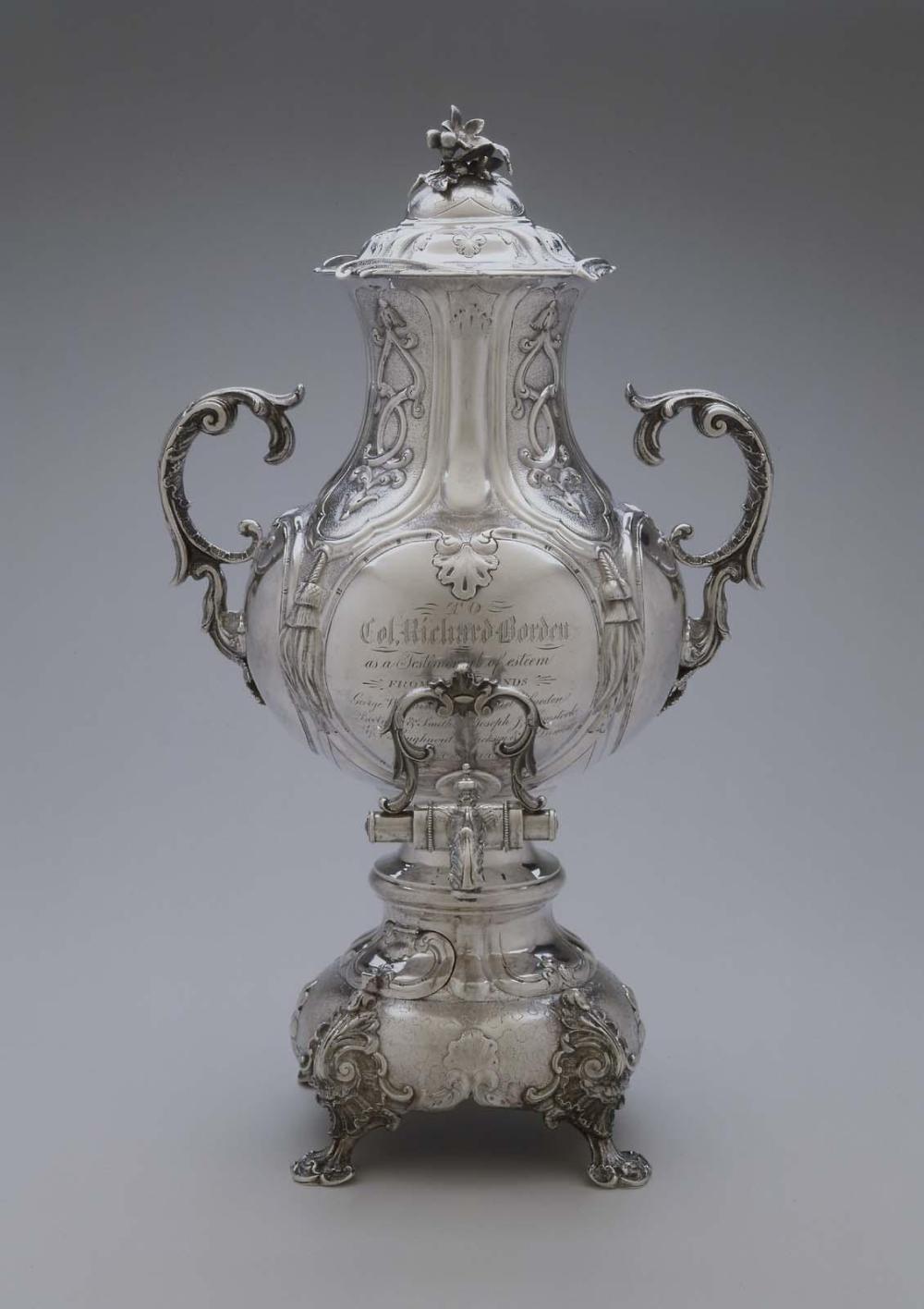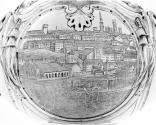Advanced Search
Coffee urn
Cann & Dunn (1856–1860)
John Cann (American, active 1848–1867)
David Dunn (American, active 1848–1860)
John Cann (American, active 1848–1867)
David Dunn (American, active 1848–1860)
about 1855
Object Place: Brooklyn, New York, United States
Medium/Technique
Silver
Dimensions
Overall: 47 x 28.5 x 28.5 cm, 2.58 kg (18 1/2 x 11 1/4 x 11 1/4 in., 5.69 lb.)
Credit Line
Gift of Miss Caroline Borden
Accession Number14.516a-b
NOT ON VIEW
CollectionsAmericas
ClassificationsSilver hollowware
This sumptuous coffee urn was part of a six-piece tea and coffee service presented in 1855 to Col. Richard Borden (1795 – 1874), a Fall River businessman who earned his military rank during the War of 1812. He then began his career as a shipbuilder and founder of the Fall River Iron Works Company, organized in 1821. The company prospered and became the source of capital for the Fall River Steamboat Line, which became possible in 1845 with the establishment of the Old Colony railroad line from Boston to Fall River. Presented in 1855, this coffee urn and its accompanying pieces may have commemorated the date of Borden’s decision to establish the steamship line founded in 1847, which operated, in conjunction with the rail line, between Fall River and New York City until 1937. An elaborate scene of the Taunton River, bustling with steamboats and other water traffic set against the Fall River skyline, is engraved on the back of the urn, opposite the inscription.
John Cann and David Dunn worked with Thomas Charters Jr. as Charters, Cann & Dunn from 1848 to 1854 on Frankfort Street in New York. When Charters departed, Cann and Dunn moved their shop to Jay Street in Brooklyn (see cat. no. 185), where they continued as Cann and Dunn from 1855 to 1857. The earlier firm’s three-part manufacturing logo featured a lion in the left position and the initials “C C & D” and an arm and hammer in the center and right positions. Cann & Dunn may have used the same three-part logo without the first “C” in the center position. The firm operated as a wholesaler specializing in hollowware for the trade. They were a popular source of presentation silver and esteemed for the quality of their work.
This text has been adapted from "Silver of the Americas, 1600-2000," edited by Jeannine Falino and Gerald W.R. Ward, published in 2008 by the MFA. Complete references can be found in that publication.
John Cann and David Dunn worked with Thomas Charters Jr. as Charters, Cann & Dunn from 1848 to 1854 on Frankfort Street in New York. When Charters departed, Cann and Dunn moved their shop to Jay Street in Brooklyn (see cat. no. 185), where they continued as Cann and Dunn from 1855 to 1857. The earlier firm’s three-part manufacturing logo featured a lion in the left position and the initials “C C & D” and an arm and hammer in the center and right positions. Cann & Dunn may have used the same three-part logo without the first “C” in the center position. The firm operated as a wholesaler specializing in hollowware for the trade. They were a popular source of presentation silver and esteemed for the quality of their work.
This text has been adapted from "Silver of the Americas, 1600-2000," edited by Jeannine Falino and Gerald W.R. Ward, published in 2008 by the MFA. Complete references can be found in that publication.
DescriptionThe bulb-shaped urn has a separate lid and scrolled foliate handles attached with split stem to the widest part of the body and curving up toward the extended neck. The urn's slender cylindrical stem broadens into a round base that sits on four cast shell and foliage feet. A hinged panel on the base provides access to the wick of the alcohol lamp which twists in from below. The urn and base are elaborately decorated with a repouseé-chased design of panels, strapwork and tassels above four large scroll-edged reserves for engraving and placement of the handles. Highly polished areas of the surface contrast with dark, heavily stippled surfaces and lighter areas with a single curving line of stippling. The separate bezel-set domed lid is topped with a floral finial. The lid is fitted above a pierced silver ring to which is sewn a cloth filter to contain the ground coffee. To pour the beverage, the server lowers a scroll-shaped lever that loops above a spigot decorated with floral chasing. At the back of the urn, opposite the front, is an elaborate harbor scene engraved within one of the four reserves.
Marks
Stamped on the bottom of the body of the urn below the center point with a three-part manufacturing logo "(lion")? / "C & D" / "(arm and hammer)." The left element is illegible in this mark. Charters, Cann & Dunn's mark had had a lion in the left position with initials ("C C & D") and an arm and hammering following in the center and right positions.
InscriptionsOn the body of the urn in a frontal reserve above the spigot: "To / Col. Richard Borden / As a Testimony of Esteem / From His Friends / George W. Quintard, Samuel Sneden / Bootman & Smith Joseph K. Comstock / E. V. Haughwout / Jackson & McDermott / August 1855" A later inscription is engraved in script on a rectangular plaque attached over the base in the front of the urn "Coffee-urn / belonging to a service of six pieces / made from exclusive designs / and presented to / Richard Borden Fall River / Presernted by his daughter / Caroline Borden"
ProvenanceThe urn descended from Richard Borden (1795 – 1874) to his oldest child and only daughter, Caroline Borden (1829 – 1922), the donor.




